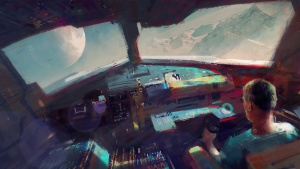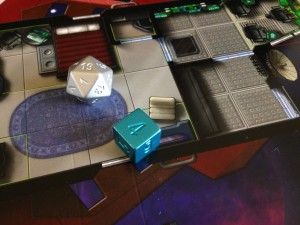 Today we’re going to take a closer look at the Protostar setting for our upcoming Alternity Science Fiction Roleplaying Game, now live on Kickstater! Protostar serves as a sample sci-fi setting in the Alternity Core Rulebook—it’s a medium-future, hard-SF setting in which humanity has spread throughout the Solar System and is beginning to explore and colonize the nearby stars. Interested in planetary surveys, vicious corporate competition, power politics, and alien mysteries? You’ll like Protostar. Not interested? No problem, it’s not hardwired into the rulebook—you’ll have plenty of material for building your own setting. Read on! Continue reading
Today we’re going to take a closer look at the Protostar setting for our upcoming Alternity Science Fiction Roleplaying Game, now live on Kickstater! Protostar serves as a sample sci-fi setting in the Alternity Core Rulebook—it’s a medium-future, hard-SF setting in which humanity has spread throughout the Solar System and is beginning to explore and colonize the nearby stars. Interested in planetary surveys, vicious corporate competition, power politics, and alien mysteries? You’ll like Protostar. Not interested? No problem, it’s not hardwired into the rulebook—you’ll have plenty of material for building your own setting. Read on! Continue reading
Category Archives: Alternity
Alternity Cleared for Launch, Countdown Commencing
 We at Sasquatch are pleased to announce that Alternity launches Tuesday, April 4, on Kickstarter. (Update! The project is now live!) In case you don’t yet know, Alternity is a science-fiction RPG with everything from interstellar exploration, post-apocalyptic survival, or near-future government conspiracies.
We at Sasquatch are pleased to announce that Alternity launches Tuesday, April 4, on Kickstarter. (Update! The project is now live!) In case you don’t yet know, Alternity is a science-fiction RPG with everything from interstellar exploration, post-apocalyptic survival, or near-future government conspiracies.
Available as a full-color 240-page hardbound book or device-friendly PDF, Alternity is a toolbox that enables a group of players to explore whatever SF genre inspires them. Golden-age space operas, steampunk intrigues, and post-singularity dramas are all possible, as are titanic space battles, alien contact missions, and speeder chases across strange landscapes.
Alternity’s release extends beyond the core rulebook, as two key sourcebooks will be available at launch: the Shipyard provides ship construction rules, deck plans, and statistics for dozens of starships of all tech levels; and the Protostar Mission Guide provides a campaign overview and adventures that explore the most dangerous places in the galaxy. Both sourcebooks can be had as softcover books or PDFs, and stretch goals throughout the Kickstarter campaign will unlock additional sourcebooks such as the Xenologist’s Guide to Aliens, a second setting book, and more!
 Alternity was designed by award-winning RPG designers Rich Baker, David Noonan, and Stephen Schubert, with consultation and guidance from Bill Slavicsek. Baker and Slavicsek’s work on the project marks a reunion of sorts for the duo, who designed a version of Alternity in the 1990’s.
Alternity was designed by award-winning RPG designers Rich Baker, David Noonan, and Stephen Schubert, with consultation and guidance from Bill Slavicsek. Baker and Slavicsek’s work on the project marks a reunion of sorts for the duo, who designed a version of Alternity in the 1990’s.
The Beta release of Alternity is now available as a free download on DriveThruRPG. The Beta release includes an overview of the rules, an introductory scenario, and an adventure with pre-generated characters. We’ll also be posting a survey tomorrow (April 4) to get even more directed feedback on our playtests.
Alternity Design Blog #13: Our Playtest Process
 We’ve just released the Beta version of our Alternity Quickstart Guide (now available as a free download on DriveThruRPG), which provides an introduction to the gameplay and systems we’re creating for the Alternity Sci-Fi RPG. We’ve already had hundreds of playtesters involved in our Alpha release, and we are working diligently at evaluating the feedback we’ve already received while also gearing up to get even more responses from our beta test. For this design blog, Stephen’s here to elaborate upon our playtesting process: what can we learn, and how do we get that information? Read on! Continue reading
We’ve just released the Beta version of our Alternity Quickstart Guide (now available as a free download on DriveThruRPG), which provides an introduction to the gameplay and systems we’re creating for the Alternity Sci-Fi RPG. We’ve already had hundreds of playtesters involved in our Alpha release, and we are working diligently at evaluating the feedback we’ve already received while also gearing up to get even more responses from our beta test. For this design blog, Stephen’s here to elaborate upon our playtesting process: what can we learn, and how do we get that information? Read on! Continue reading
Alternity Design Blog #12: What’s your Sci-Fi Inspiration?
 The science fiction we read and watch provides inspiration for our own stories and worlds. We here at Sasquatch HQ are clearly fans of a variety of sci-fi. After all, we grew up with Star Wars and Star Trek, and sci-fi has always been a part of our lives. This week, we wanted to each take a moment to describe 10 or so science fiction properties that inspire us as we are working on the Alternity Science Fiction RPG. Continue reading
The science fiction we read and watch provides inspiration for our own stories and worlds. We here at Sasquatch HQ are clearly fans of a variety of sci-fi. After all, we grew up with Star Wars and Star Trek, and sci-fi has always been a part of our lives. This week, we wanted to each take a moment to describe 10 or so science fiction properties that inspire us as we are working on the Alternity Science Fiction RPG. Continue reading
Alternity Design Blog #11: Swords in a Gunfight
 Our playtests are underway (be sure to give us feedback via our survey), and in this installment of our Alternity Design Blog, Rich provides some insight on the sorts of decisions that we make as we refine the Alternity system. Take it away, Rich!
Our playtests are underway (be sure to give us feedback via our survey), and in this installment of our Alternity Design Blog, Rich provides some insight on the sorts of decisions that we make as we refine the Alternity system. Take it away, Rich!
We were playing Alternity at Sasquatch HQ recently, and we ran into a development challenge that we’d been putting off so far. Here’s the basic scenario: We were fighting security robots in a deserted space station when a door slid open and a big security ‘bot armed with a blast cannon clanked into the room. Realizing that my twin heavy pistols wouldn’t do much against its armor and that I might get shot to pieces by all the other robots if I stayed at range, I decided to get up close and personal. I drew my diskos (a powered melee weapon, basically a hypersharp buzzsaw on a haft) and moved up to melee range to start carving on the heavy robot. And then Steve, the GM, asked, “So can that big robot keep shooting you, or what?”
Steve note: it wasn’t so much that I didn’t know what to do, but really that it was a situation it felt we should address in the game rules. As Rich outlines below, our answer will have significant impact on the style of play that the rules encourage. Let the discussion begin!
 Laser swords, energy maces, monomolecular blades… what’s their place on a sci-fi battlefield dominated by blaster pistols and fusion rifles? Is it just a style choice, or are they really more effective than guns in some ways? How do you avoid getting killed before you get close enough to swing? Is it “realistic” to include those things in our game? Is it *fun*?
Laser swords, energy maces, monomolecular blades… what’s their place on a sci-fi battlefield dominated by blaster pistols and fusion rifles? Is it just a style choice, or are they really more effective than guns in some ways? How do you avoid getting killed before you get close enough to swing? Is it “realistic” to include those things in our game? Is it *fun*?
We’ll begin with “real life” for a moment: Guns are as lethal as swords, or more so. Weapons that kill from farther away are better than weapons that must be used at close range, especially if you can kill your enemy before he can threaten you. And guns can still be very dangerous in hand-to-hand combat; it’s not all that much harder to shoot a bad guy with a pistol than it is to stab him with a knife. There’s a reason that SWAT teams storming even the smallest rooms go in with guns drawn, not swords or battle axes or handheld stun-guns. In summary, if you have a choice between a sword and a handgun, you should probably pick up the handgun.
So, with that in mind, why do sci-fi heroes still bother with melee weapons at all? I can think of three *potential* reasons: 1) they’re all that’s available; 2) they do more damage than guns; or 3) they put gun-wielders at a disadvantage.
Limited Availability
In a sci-fi game, you might find yourself in a primitive survival situation where your laser pistol isn’t available. You might confront aliens who attack you with tooth and claw, or low-tech societies that come at you with maces and longswords. You might have to leave your guns on the ship to enter a security-restricted area. Or you might find that ammunition is a real limitation—if you empty your six-shooter, you might have to resort to your knife if the bad guys are still coming. There are all kinds of reasons guns might not be available to you.
Creating combats where guns aren’t available to some or all participants is certainly easy enough for the GM. In this scenario you just admit that guns are better than swords. The trouble is, players who want to run brawlers or Wookies or cyber-samurai don’t see much incentive to sink skill points and resources into getting good at a suboptimal strategy.
Melee Weapons Outperform Guns
OK, so it’s not realistic. A 9mm bullet is every bit as deadly as a sword blade. But this at least creates a good “game” solution: You can choose between doing more damage and exposing yourself to more danger, or doing less damage and playing it safe. This is why lightsabers are cool in a Star Wars game: in most systems, Jedi carve you up when they get close (ed note: it might also be because they are highly trained jedi). We could certainly create an Alternity game in which we assign oversized damage ratings to melee attacks, and we’d see plenty of players make the decision to specialize in close combat instead of ranged combat. The downside of this approach is not only the realism, but also the way such an approach would turn combat away from the way we most frequently envision sci-fi battles: laser blasts and explosions.
Guns Disadvantaged in Melee
Finally, we could create a rules set that says guns don’t work in melee (or don’t work as well as melee weapons, anyway). Old D&D rules simply prohibited ranged weapons in melee—the rules said that you literally could not pull the trigger of that crossbow if a goblin based you. Later rules allowed you to make that crossbow attack, but attached a nasty penalty or risk such as provoking an opportunity attack. This approach is a little more realistic than approach 2; I don’t have to pretend that a sword slash is deadlier than a bullet wound, and I can easily imagine that a rifle could be knocked aside or grabbed. But no one in the real world says, “Well, let me grab a baseball bat, so that I can get up next to the bad guy and make sure he doesn’t shoot anybody.”
On the bright side, this approach offers reasonable support for the player who wants to build a brawler or a chainsword berserker, just like option 2. That character feels better about being in melee than the gun-wielder he bases. Melee specialists have plenty of reason to keep the combat mobile, not static. And guns can be “better” than swords as they probably should be, right up to the moment they’re not. I leave the realism debate to the experts, but it’s a satisfactory solution for a game.
So which way should we go with Alternity? We’re leaning toward Option 3. We think a rule that says something like “rifles and heavy weapons take a -3 step penalty to attacks if an enemy’s adjacent to you” is pretty reasonable. Melee specialists can’t guarantee that they’ll shut down an enemy rifleman, but they can make him a lot less effective. That rifleman’s not happy that you’re basing him, and you’re rewarded for *moving* in the action scene, and that’s all good.
We also think that the penalty shouldn’t apply to guns intended for close quarters. People use pistols at fist-fighting range all the time, after all. Their penalty for letting the melee specialist get close is that they’re now in his attack range. And giving pistols the advantage of suffering no penalty in melee helps to provide a point of differentiation between rifles and pistols in our game. Otherwise, rifles would always be the right answer, and that’s not good for a game either!

Alternity Design Blog #10: Taking Damage!
 In today’s blog, we’re taking a look at the current iteration of our take on Alternity’s damage and wound system. As with other sneak peeks at our design, this is a snapshot of a work in progress, and we expect to continue to refine and adjust the systems as we get closer to launch. Read on! Continue reading
In today’s blog, we’re taking a look at the current iteration of our take on Alternity’s damage and wound system. As with other sneak peeks at our design, this is a snapshot of a work in progress, and we expect to continue to refine and adjust the systems as we get closer to launch. Read on! Continue reading
Alternity Design Blog #9: AcadeCon Playtest part 1
 While we’ve been quiet the past few weeks, much work has been happening behind the scenes to prepare Alternity for playtest. As part of that process, Rich performed a dry run of the playtest rules at AcadeCon 2016 a few weeks back, and ran a couple of scenarios of Alternity for the RPG Academy fans in attendance. Here’s part 1 of his convention report! Continue reading
While we’ve been quiet the past few weeks, much work has been happening behind the scenes to prepare Alternity for playtest. As part of that process, Rich performed a dry run of the playtest rules at AcadeCon 2016 a few weeks back, and ran a couple of scenarios of Alternity for the RPG Academy fans in attendance. Here’s part 1 of his convention report! Continue reading
Alternity Design Blog #6: Musing on Archetypes
We’ve had tremendous interest thus far from fans interested in the upcoming Alternity Playtest, which has exceeded our expectations! We’ll continue collecting email addresses (you can sign up here on our previous blog entry), and we’ll provide more information about the playtest plan in the coming weeks. In the meantime, Rich would like to share some thoughts on player archetypes – take it away, Rich!
Alternity Design Blog #5: Sign Up for Playtesting
Want to be help playtest Alternity? Sign up here! Continue reading
Alternity Design Blog #4: Encounters and Improvisation
This week, Dave gives a glimpse of how our approach to Alternity affects encounter design and enables improvisation. Take it away, Dave!
Your “Alterniteers” (Rich, Bill, Steve, and I) are hard at work on building the first public playtest packet. Look for it soon! As we do that, here are a couple of “hey, that’s kinda neat” moments that emerged from our design work thus far. Continue reading

